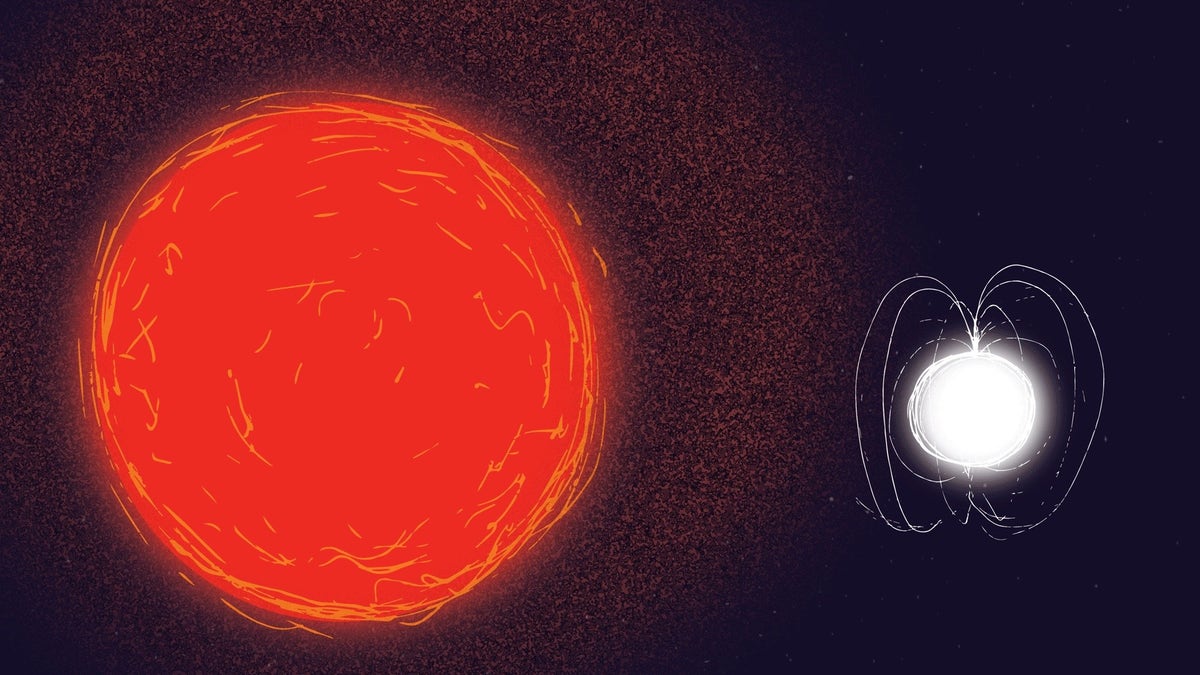
An artist's illustration showing winds from a red-giant star impacting a neutron star to create prolonged X-ray emission. Such a system is rare; no more than 10 are currently known. One was detected "switching on" in X-ray light in August 2017, by the European Space Agency's Integral satellite. (ESA)
The superdense corpse of a once-massive star roared back to life, briefly, by feasting on its dying companion, a new study suggests.
In August 2017, the European Space Agency's (ESA) International Gamma-Ray Astrophysics Laboratory satellite, known as Integral, detected a powerful flash of X-ray light coming from the direction of the Milky Way's core.
In the new study, researchers reported that the flash was likely emitted by a stellar remnant known as a neutron star, which had just begun siphoning material away from its bloated, nearly dead companion, a red giant. [Inside a Neutron Star (Infographic)]
Many huge stars end up as neutron stars: After racing through their fuel supplies, they explode as dramatic supernovas, the remnants of which collapse to form either black holes or neutron stars. The latter are some of the densest objects known, packing more than a sun's mass of material into a sphere just 6 miles (10 kilometers) or so wide.
More From Space.com
Red giants are similarly common. Both sun-like stars and red dwarfs go through this bloated phase as they're dying. (After death, these smaller stars become white dwarfs, remnants that aren’t quite as dense as neutron stars.)
But the type of neutron-star/red-giant pairing described in the new study, called a "symbiotic X-ray binary," is extremely rare: No more than 10 have ever been spotted across the cosmos, study team members said.
"Integral caught a unique moment in the birth of a rare binary system," lead author Enrico Bozzo, from the University of Geneva, said in a statement. "The red giant released a sufficiently dense, slow wind to feed its neutron star companion, giving rise to high-energy emission from the dead stellar core for the first time."
Observations by other instruments revealed more about the system. For example, measurements by ESA's XMM-Newton and NASA's NuSTAR space telescopes showed that the neutron star rotates just once every 2 hours, researchers said. That's very slow; some neutron stars can spin many times per second.
And NuSTAR data indicated that the revived neutron star has a powerful magnetic field — typically, a characteristic of a young neutron star. That's odd, because the red giant is an oldster. (Our sun won't reach the red-giant phase until it's about 10 billion years old.) So, what are the two stars doing together?
"These objects are puzzling," Bozzo said. "It might be that either the neutron star magnetic field does not decay substantially with time after al or the neutron star actually formed later in the history of the binary system. That would mean it collapsed from a white dwarf into a neutron star as a result of feeding off the red giant over a long time, rather than becoming a neutron star as a result of a more traditional supernova explosion of a short-lived massive star."
Integral, a collaboration involving ESA, the Russian space agency and NASA, has been studying the universe in high-energy light since the instrument launched to Earth orbit in 2002.
The new study has been accepted for publication in the journal Astronomy & Astrophysics.
Originally published on Space.com.




















